Do you want to learn about the MOST Common Weeds in California?
Finding a Guide to the MOST Common Weeds in California was not as easy as I thought. There are lots of weeds in California and some of the guides were too broad, others were irrelevant, and some didn’t provide enough information.
That’s why I created a list of the 10 MOST Common Weeds in California.
This ultimate guide will not only give you the most common bees in South Carolina but also important and interesting facts about them.
10 Most Common Lawn Weeds in California
#1. Bittercress (Cardamine hirsute)
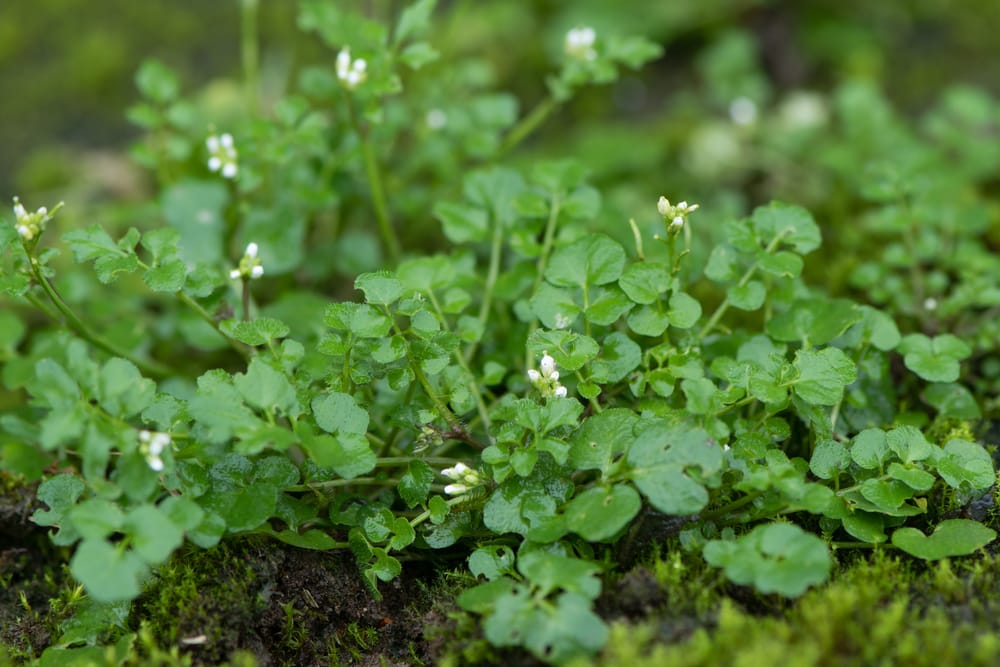
Identifying Characteristics and Facts
- Small and fast-growing.
- About 4 – 12 inches tall.
- Its leaves are deeply lobed.
- Has small and slender stems.
- Produces cluster of small white flowers and blooms during the spring and early summer.
- Produces small and cylindrical seedpods.
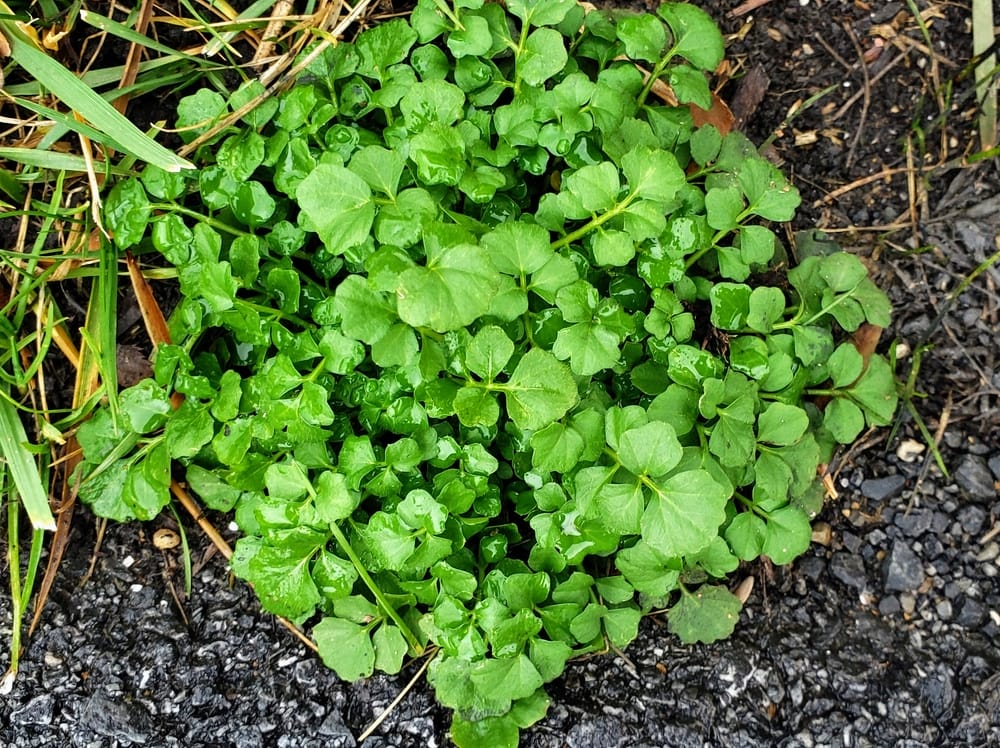
Bittercress weed can be found in shady and wet areas of your lawn. The weed is popular in California and grows faster than even lawn grass.
You do not want to have this weed on your lawn since it is invasive. The weed can disperse its seeds as far as 16 feet away and this has made it become one of the biggest problems when it comes to taking care of the lawn. Once it spreads, it’s hard to stop.
Believe it or not, but you can eat Bittercress Weed. The hairy and wavy bittercress weeds are edible. It is also important to note that the flavor is bitter and mild and therefore useful as a garnish in most salads.
#2. White Clover (Trifolium repens)
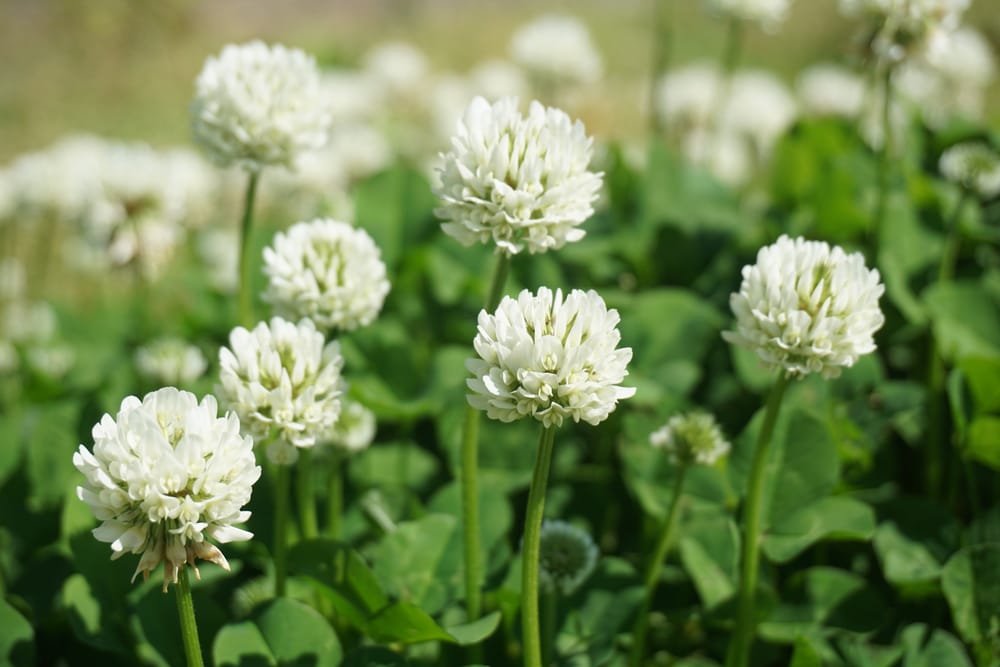
Identifying Characteristics and Facts
- Wedge-shaped leaflets. The leaves are serrated at the margins.
- Low-growing and are about 4 – 8 inches tall.
- Leaves are about 1.5 – 2.5 cm long.
- Have clusters of white or pinkish-white small flowers.
- Have hairy stems.
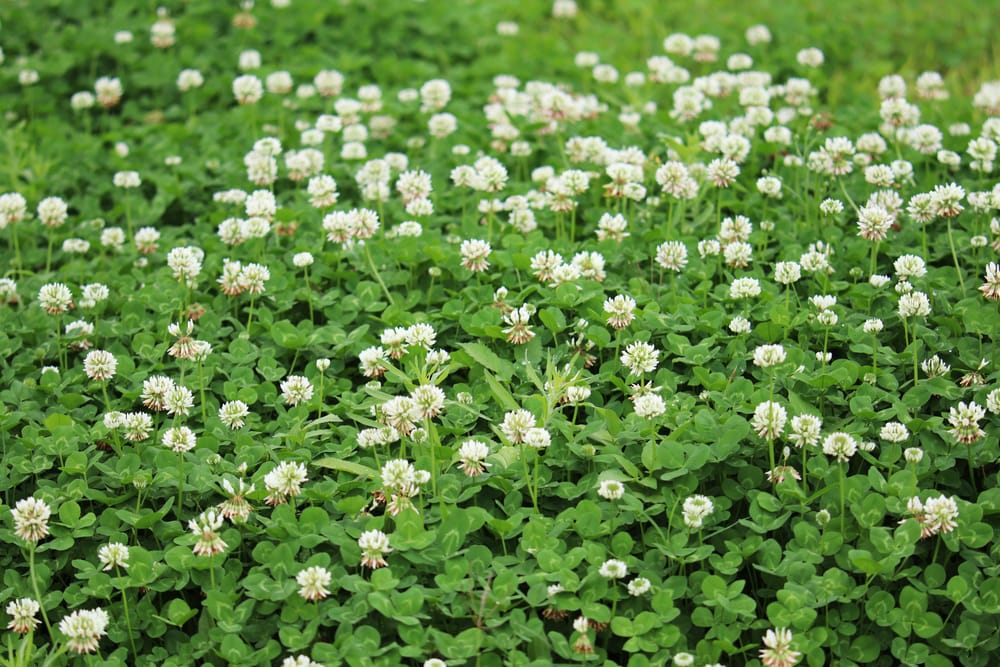
White Clovers are vigorous weeds that grow rapidly in lawns, gardens, meadows, and grasslands. These weeds are common in California and you will spot them in areas that have moist soil.
Being a perennial weed means it can live for many years. You will see the blooms from the beginning of spring all through to early fall. Once this weed begins to spread it can quickly take over your entire yard.
While this weed can be a nuisance, it also has great benefits for gardens and pollinators. It is known to fix nitrogen in the soil and hence improve soil fertility. In addition to that, it is a great source of nectar for the bees and some other pollinators.
- Related: USEFUL Plants that Attract Bees
#3. Black Medic (Medicago lupulina)
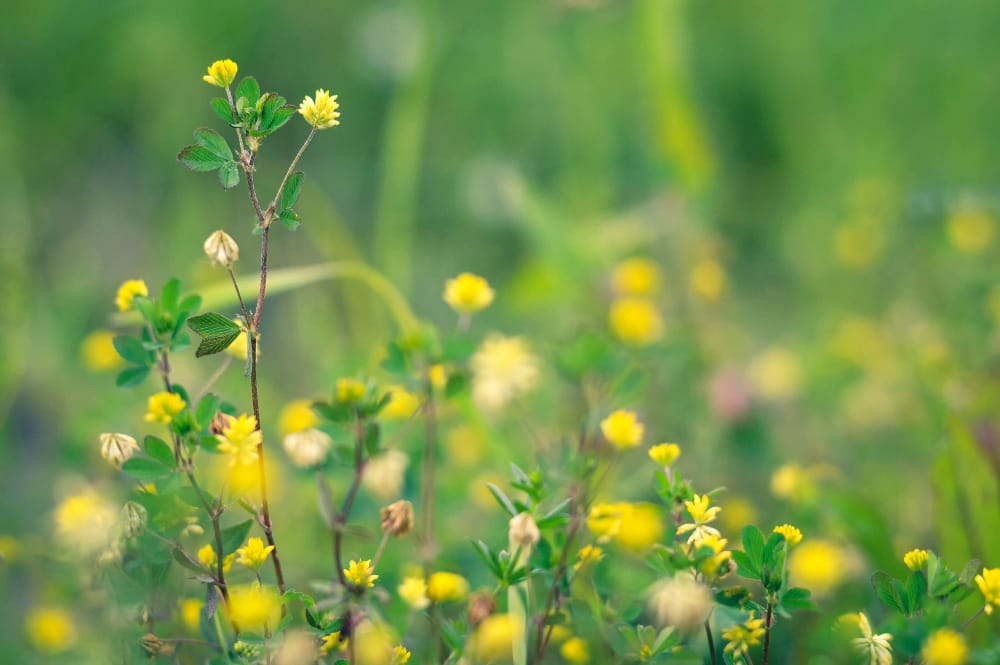
Identifying Characteristics and Facts
- It grows to about 0.5 m tall.
- Have compound and alternate trifoliate leaves and broad leaves of about 17 mm wide.
- Blooms from late spring to early fall.
- They produce clusters of small yellow flowers.
- Produces clustered seedpods each containing one seed.
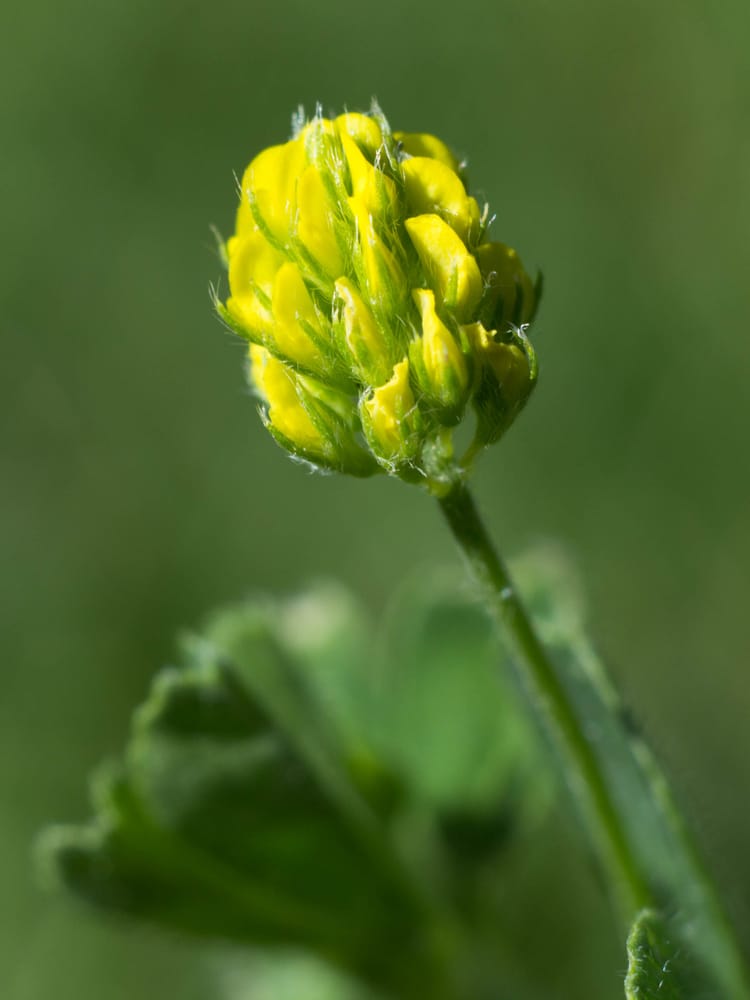
Black Medic is a common lawn weed in California. It grows in a wide range of soils including the loam soil, sandy, and clay soils. Apart from the lawns, you will also find this weed in grasslands, along the roadsides, and in the gardens.
One thing you need to know about this Medicago lupulina is that it grows rapidly and spreads faster. Therefore, it is an invasive weed that you need to control. One of the ways of controlling includes regular mowing, the use of herbicides, and hand pulling.
- Related: BEST Weed Killers for Gardeners
In addition to that, the black medic produces hard small seeds that will remain viable in the soil for very many years and should be pulled or destroyed immediately.
#4. Henbit (Lamium amplexicaule)
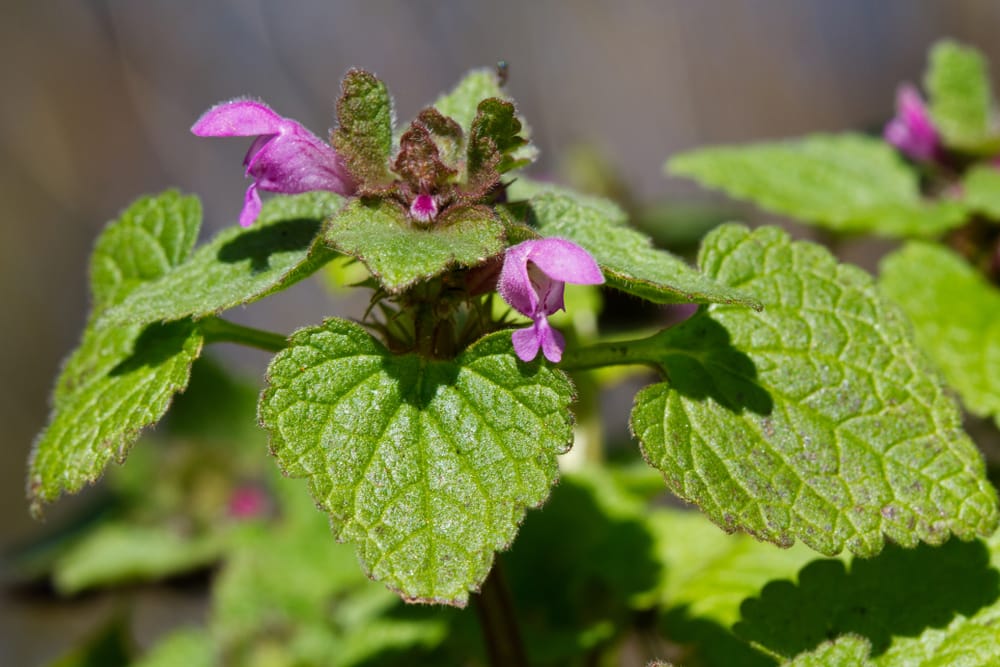
Identifying Characteristics and Facts
- Grows to a height of 16 inches.
- Has a fibrous root system.
- Has a square stem and heart-shaped leaves and the leaves are dull green and opposite each other on the stem.
- Produces cluster of pinkish to purple flowers with hooded shape at its top.
- Leaves have prominent veins on the underside.
- A single henbit plant can produce up to 2000 seeds.
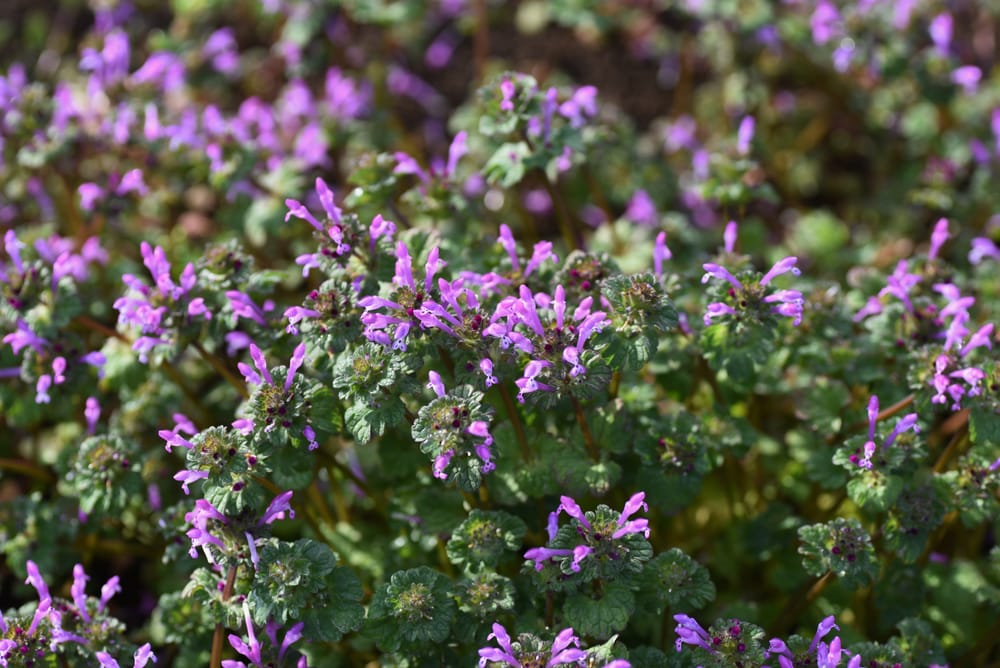
Henbit weed grows in a wide variety of habitats. You will see them in the lawns, gardens, waste places, and even on the roadsides. It is one of the common lawn weeds in California and is also distributed fairly around the world.
One of the beneficial uses of this plant is that it helps in relieving chronic pain, stiffness, and soreness. Therefore, you can use it as a laxative among other uses.
It is also important to note that this weed is useful in crop fields as it helps in controlling erosion. The plant is also considered to be invasive and when it grows on lawns, it becomes difficult to manage.
#5. Purslane (Portulaca oleracea)
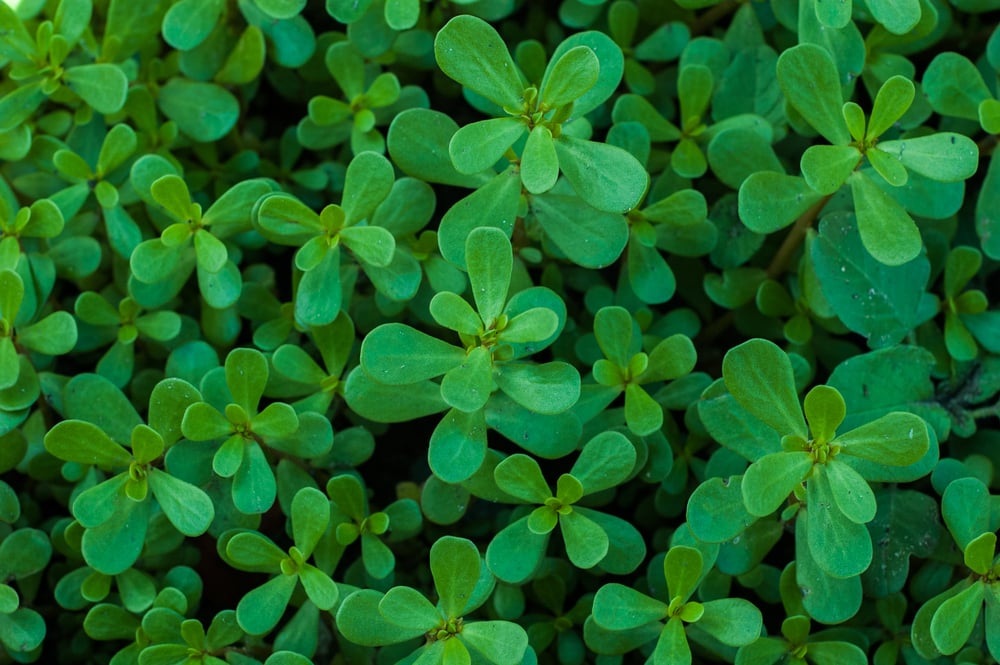
Identifying Characteristics and Facts
- Small with succulent leaves.
- Can grow to about 4 – 8 inches tall.
- Can spread rapidly on the ground.
- Drought-tolerant hence the ability to survive dry environments.
- Leaves that are green and sometimes tinged with red and there may be leaves on alternate stems.
- Leaves are mostly oval but sometimes oblong.
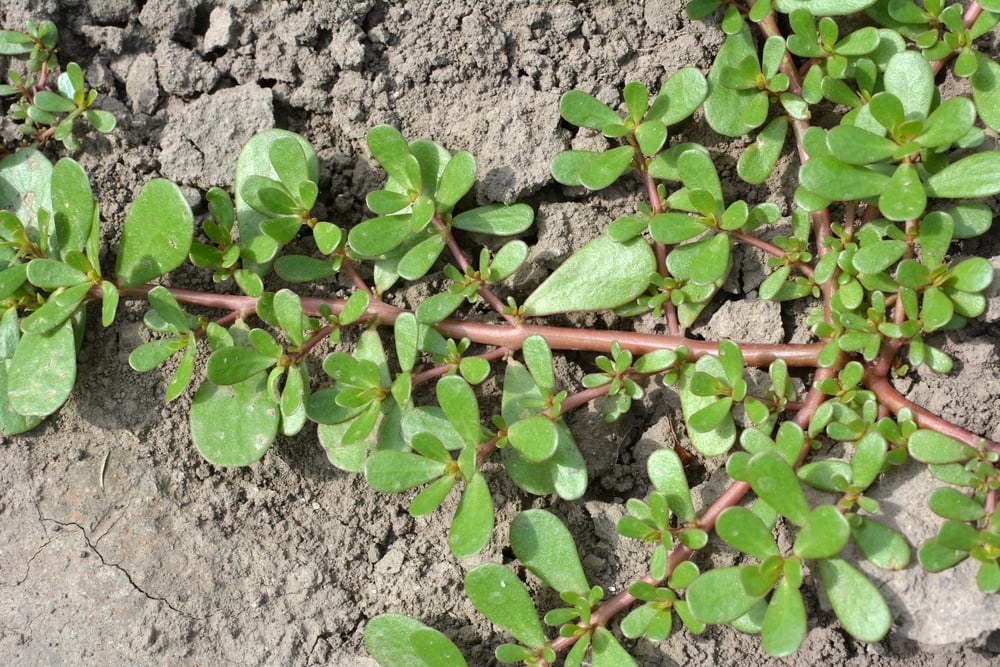
You will not miss finding these weeds in California. They are plenty in warm environments with sunny conditions. They also grow in different types of soils and hence the likelihood to find in most gardens, lawns, open fields, and sometimes even between concrete.
This weed though can be a nuisance and is edible. It is, therefore, useful in salads and soups. This is because it is a good source of nutrients such as Vitamins E, C, and magnesium. It has also been discovered to be rich in Omega 3 fatty acids.
In the absence of favorable growing conditions, the seeds can remain viable in the soil for several years. The reason why purslane is considered to be a weed is because it can outcompete other plants or crops.
#6. Bindweed (Convolvulus arvensis)
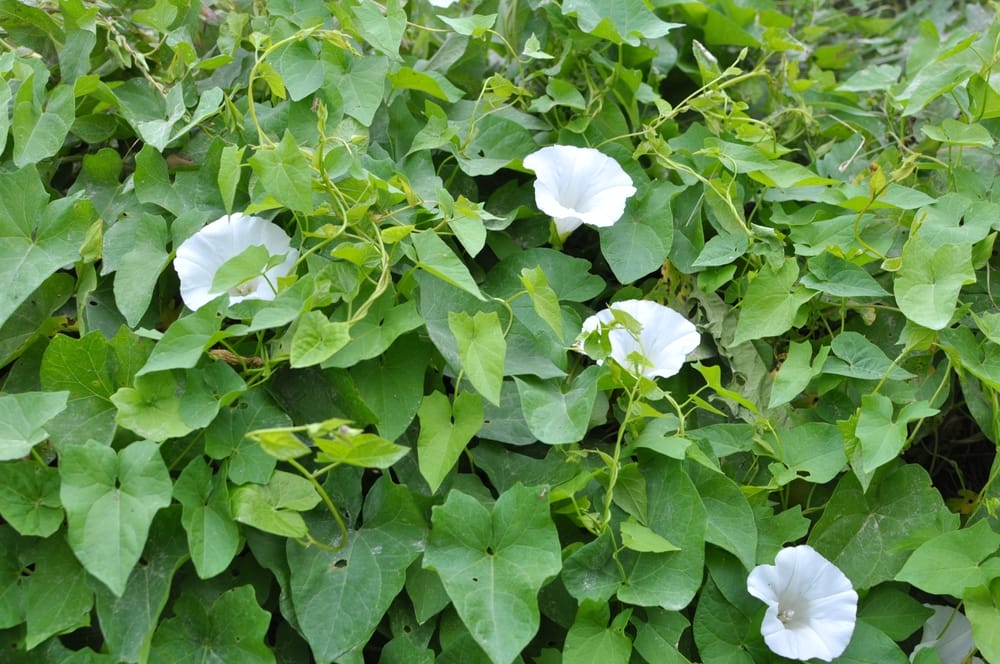
Identifying Characteristics and Facts
- Arrow-shaped alternate leaves with rounded apex.
- Leaves are about 1 – 2.5 inches long.
- Grows along the ground and to about 6.5 feet long.
- Have thin and wiry stems with fine hairs.
- Have whitish or pinkish trumpet-shaped flowers.
- Roots can grow to as deep as 30 feet and 10 feet spread.
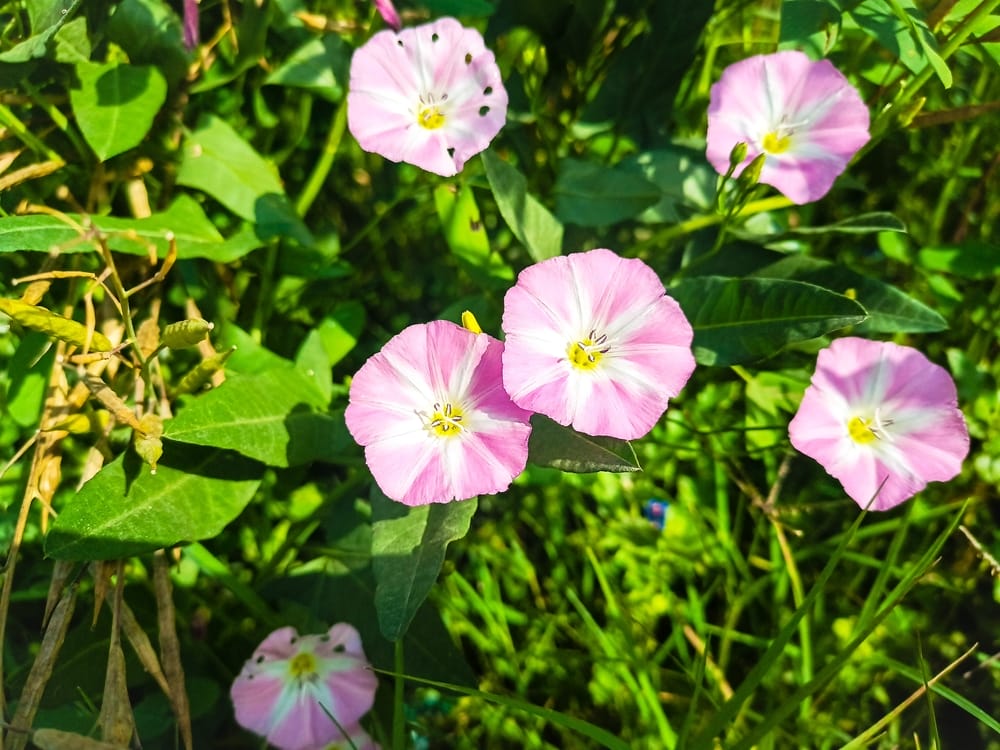
Bindweed is one of the most difficult weeds to deal with. You will find these weeds in lawns, gardens, and fields among other habitats.
When it comes to reproduction, these lawn weeds reproduce by seed and also through their spreading root system. The fact that the roots can go as deep as 30 feet and up to 10 feet horizontally means it is difficult to control.
The weed grows forming dense mats on the ground. This outcompetes native crops and vegetation and hence can lead to reduced crop yields.
As I mentioned, it is difficult to deal with this kind of weed. However, you can try some methods such as the use of herbicides, cutting the plant repeatedly, or hand pulling whenever you see them.
#7. Creeping Charlie (Glechoma hedracea)

Identifying Characteristics and Facts
- Has runners that spread up to 7 feet long.
- Has round-shaped leaves and the Leaves are about 1 -2 inches wide with scalloped edges.
- Have square stems that grow to about 2 feet long.
- Produces blue-violet, funnel-shaped small flowers.
- Forms dense mat of vegetation on the ground.
- Spreads rapidly and grows in different soil types.
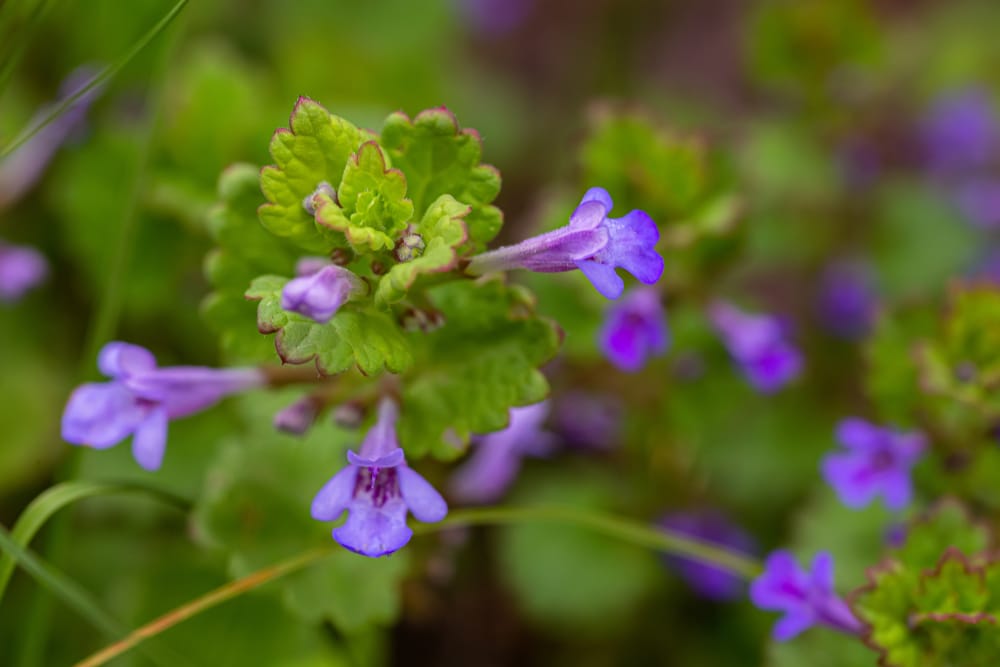
Another weed that you cannot miss on California lawns is the Creeping Charlie. This weed is known to be invasive and grows in moist and shady environments.
If left untouched, this weed can easily take over the lawns or gardens. One thing you should also note about creeping Charlie is that it is difficult to control. This is because it can tolerate herbicides and hence the need for combined approaches.
One benefit of this weed is its edible nature. You can use it as a garnish or in salads. The weed also has some medicinal properties making it useful in treating or managing colds and coughs.
#8. Dandelion (Taraxacum Officinale)

Identifying Characteristics and Facts
- Grows to about 3 – 12 inches high.
- Blooms in spring and summer with bright yellow flowers.
- Grows in a rosette pattern that is close to the ground.
- Have green and toothed leaves.
- After flowering, the fluffy white seed heads develop.
- They are perennials and can spread by both roots and seeds.
- They are hardy weeds and can grow in a variety of soil types.

Dandelions are common weeds you will find in California, especially in the lawns. The weeds can grow in different habitats and different soil types. However, they do well where there are moist and fertile soils.
The fact that dandelions are invasive means a lot when it comes to control. They can easily outcompete other crops or vegetation. Therefore, you should always take control by hand pulling, using herbicides, and regular mowing.
Since they are flowering, it means they are also beneficial to the ecosystem. They are a good source of nectar and pollen for bees and other insects. They also be used in numerous recipes as a sweetener.
#9. Crabgrass (Digitaria sanguinalis)
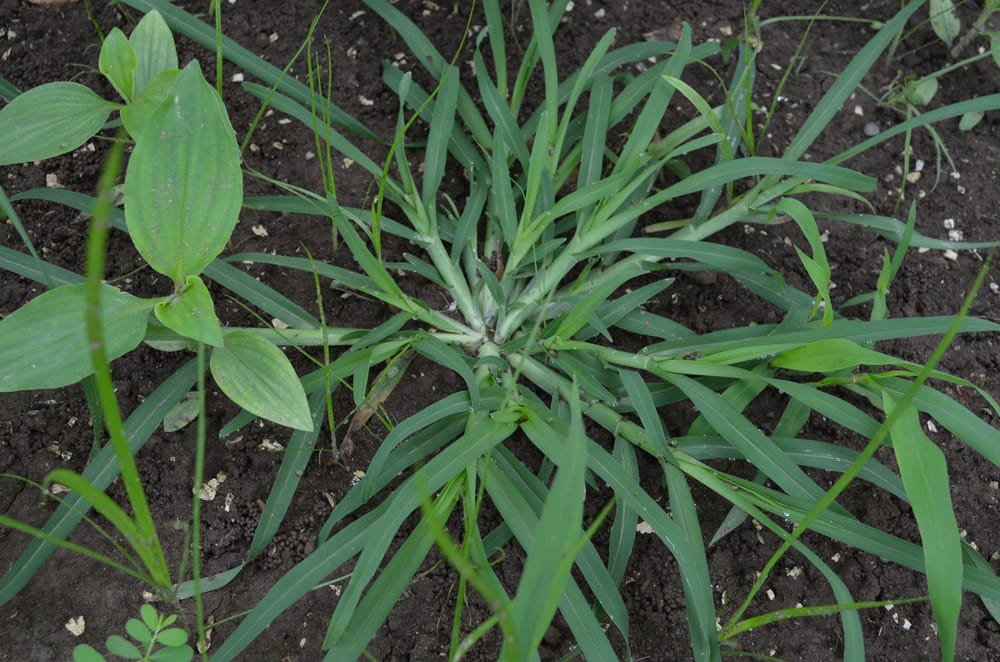
Identifying Characteristics and Facts
- Grows closer to the ground.
- Has flat pale-green wide leaves.
- Spreads out on the ground in a circular pattern and germinates in late spring or early summer.
- Grows faster and can easily overtake other plants.
- Can grow up to 1 foot tall if untouched.
- Annual plant and produces a large number of seeds.

Crabgrass is a common weed that you can find in California lawns. It is also known as the hairy finger grass among other names. One fact about this weed is its presence worldwide and hence a common weed across the world.
Being an annual plant means it grows and dies in one season. The seeds then germinate in late spring or early summer – just when the temperatures are about 55 – 60 degrees Fahrenheit.
Its tolerant nature makes it a great problem in gardens and in lawns. It is difficult to control since it can tolerate dry conditions and even poor soil conditions. Also, it can resist herbicides making it difficult to keep the lawns healthy and well-maintained.
#10. Chickweed (Stellaria media)
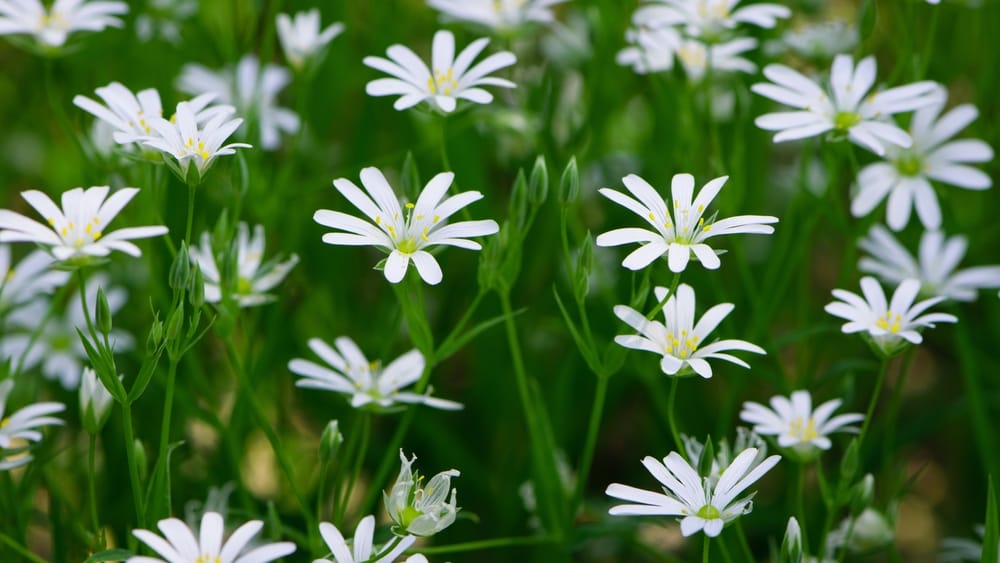
Identifying Characteristics and Facts
- Small oval-shaped leaves.
- Leaves are arranged opposite each other on the stem.
- Grows to about 3 – 6 inches in the sun and up to 18 inches in shade.
- Has a thin green stem.
- Blooms in spring and summer with small white flowers.
- Hardy and grows in different habitats.

Chickweed is a common weed in California but is also found in many parts of the world. You will see them in the lawns, gardens, and in the fields among other habitats.
As mentioned, chickweed is hardy but prefers moist, shady, environments or full sun. It is also worth understanding that the plant can produce thousands of seeds that can remain viable in the soil for several years.
There is also a beneficial aspect of this weed. It flowers and that means bees and other insect that eat nectar benefits from it. Of course, it is also edible and has a slightly sweet and nutty flavor hence used in salads, stews, and soups.
Common Factors of the Most Common Bees in South Carolina
As a reminder, the below factors are common for the most common weeds:
- Most weeds are invasive and will quickly spread
- Weeds are typically beneficial for pollinators and sometimes even to your garden
- Most weeds are either perennial or annual
- The best way to get rid of weeds is to use weed killer or remove the weeds